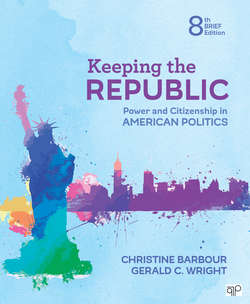Читать книгу Keeping the Republic - Christine Barbour - Страница 164
На сайте Литреса книга снята с продажи.
Protection Against Cruel and Unusual Punishment
ОглавлениеThe Eighth Amendment, which says, in part, that “cruel and unusual punishments” shall not be inflicted, has generated some major political controversies. Like some of the earlier amendments, this guarantee reflects a concern of English law, which sought to protect British subjects from torture and inhumane treatment by the king. It is easy to see why it would be controversial, however. What is “cruel,” and what is “unusual”? Despite intense lobbying on the part of impassioned interest groups, however, the Court has not ruled that the death penalty itself is cruel or unusual (except in the case of intellectually disabled individuals, juveniles, and crimes against an individual that do not result in the victim’s death),87 and most states have death penalty laws.
The strongest attack on the death penalty began in the 1970s, when the NAACP Legal Defense Fund joined with the American Civil Liberties Union and the American Bar Association to argue that the death penalty was disproportionately given to African Americans, especially those convicted of rape. They argued that this was a violation of the Eighth Amendment and of the Fourteenth Amendment guarantee of equal protection of the law. Part of the problem was that state laws differed about what constituted grounds for imposing the death penalty, and juries had no uniform standards to rely on. Consequently, unequal patterns of application of the penalty developed.
In Furman v. Georgia (1972) and two related cases, the Court ruled that Georgia’s and Texas’s capital punishment laws were unconstitutional, but the justices were so far from agreement that they all filed separate opinions, totaling 231 pages.88 Thirty-five states passed new laws trying to meet the Court’s objections and to clarify the standards for capital punishment. By 1976 six hundred inmates waited on death row for the Court to approve the new laws. That year the Court ruled in several cases that the death penalty was not unconstitutional, although it struck down laws requiring the death penalty for certain crimes.89 The Court remained divided over the issue. In 1977 Gary Gilmore became the first person executed after a ten-year break.
In 1987 McCleskey v. Kemp raised the race issue again, but by then the Court was growing more conservative. It held, five to four, that statistics showing that blacks who murder whites received the death penalty more frequently than whites who murder blacks did not prove a racial bias in the law or in how it was being applied.90 The Rehnquist Court continued to knock down procedural barriers to imposing the death penalty. In 2006 the Roberts Court held that death-row inmates could challenge state lethal injection procedures in lower courts on cruel and unusual punishment grounds. Several of those courts came to different conclusions. In 2008, in Baze v. Rees,91 the Supreme Court upheld Kentucky’s lethal injection practice, and other states, waiting for a sign from the Court, went ahead with their own practices.
Public support for capital punishment appears to be softening in recent years, not because of opposition in principle but because of fears that the system might be putting innocent people on death row. This feeling grew as DNA testing cleared some death-row residents, and careful investigation showed that others, too, were innocent. After thirteen death-row convicts in his state were exonerated between 1977 and 2000, Illinois governor George Ryan, a moderate Republican who supported the death penalty in principle, called for a statewide halt to executions. “I cannot support a system, which, in its administration, has proven so fraught with error,” Ryan explained, “and has come so close to the ultimate nightmare, the state’s taking of an innocent life.”92 Following his lead, then–Maryland governor Parris Glendening issued a moratorium in 2002, but that action was quickly reversed by the new governor, Robert Ehrlich, in January 2003. In 2007 the New Jersey legislature banned the death penalty in the state—the first state to do so since the Supreme Court declared capital punishment constitutional in 1976.93 Despite misgivings, the American public continues to favor capital punishment. In 2016 a Pew poll found 49 percent of the public supporting the death penalty, with 42 percent opposed, even though majorities of both supporters and opponents thought it meant that sometimes an innocent person would be put to death.94
In Your Own Words
Describe the protections afforded criminal defendants under the Constitution.
